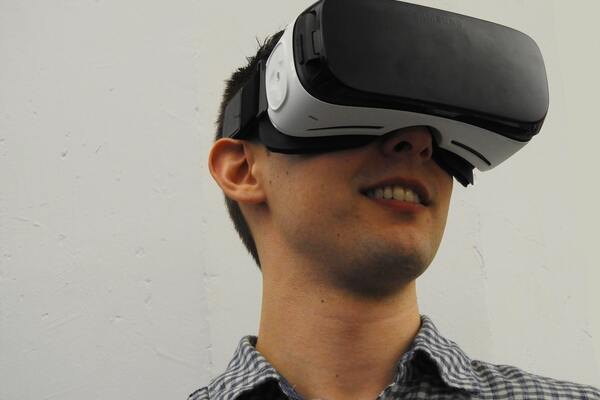For more than 50 years, Harmony has been the foundation for sustained recovery from addiction for thousands of people. Treatment methods have evolved quite substantially during those decades and Harmony continues to embrace innovation and new strategies to treat addiction and co-occurring mental health conditions.
Harmony’s chief clinical officer Dr. Annie Peters has built a mental health team that works with clients to address trauma, anxiety, depression, and other mental health issues that frequently drive SUD. Her team has recently started to use virtual reality technology to help patients in the detox phase of treatment. The VR technology enables patients to use mindfulness exercises in a calming, virtual environment while undergoing the fairly stressful detoxification process. “It’s helping clients calm down and feel more comfortable and that’s exactly what we want them to do in detox,” explains Peters.
“Emotional regulation and psychological grounding are crucial in early recovery,” says detox counselor Carla Felts, “especially when clients are going through withdrawal.” The VR allows them to experience a relaxing environment like a beach or a forest in which they do meditation exercises that can counter any anxiety they may experience.

“Learning mindfulness in a group setting can be intimidating for some clients at first,” says Felts. “In the VR, they can try it out by themselves. If it works for them, it can definitely become a springboard for patients to engage in more mindfulness meditation throughout their recovery process.”
The novel approach to treating mental health issues was developed by the National Mental Health Innovation Center (NMHIC) at the University of Colorado and is now being used at Harmony. So far, the feedback from clients has been overwhelmingly positive, says Felts. “In detox, clients are not necessarily able to go to a therapy room to practice meditation. At the same time, the environment in the detox room can be loud and activating. The VR gives them an opportunity to create a space for themselves even in this busy place.” Most clients like it so much, they come back and ask whether they can use it again after they transitioned from detox to residential treatment.
“The brain processes a virtual image much like a real image, the resulting sense of presence essentially tricks your brain into thinking you’re actually there. In VR, you can meditate anywhere you want to,” says Vogl who has bipolar disorder.
Dr. Peters shares Vogl’s assessment. “It’s much easier to visualize a calming scene when it’s right in front of your eyes. Major stress-reducing skills are about engaging your senses. The more you engage your senses and body functions like breathing, the more helpful it is for the client. When someone is distressed, we want them to be able to soothe themselves and we want them to distract from emotional pain.”
The VR can do just that for most people, but it’s obviously important to get feedback from clients to find out how it worked for them. Not all modalities are appropriate for all clients. The more the treatment approach hones in on individual needs, the more effective it becomes.
Wider Approach to Use Technological Innovation for Mental Health
In order to explore new ways to make mental health services of all kinds more accessible, the National Mental Health Innovation Center has built what they call the Tech Innovation Network (TIN). It is a partnership between the NMHIC and various community, clinical, and technology partners. Deputy director Mimi McFaul, senior project manager Sarah Beary, and program manager Gwen Gaumond coordinate the partnership with Harmony.
“Harmony Foundation has shown an unusual interest in new technology and is open to exploring new research, says McFaul. “Harmony is our superstar site in the addiction treatment sector.”
The NMHIC basically functions as a broker between two sectors: trusted tech partners developing software and treatment modalities on one side and clinical and community sites like Harmony at the other end. “There are now over 100 TIN sites and 5–7 trusted tech partners who produce excellent content, sometimes under our advisement,” explains Gwen Gaumond. “We pass that on to the community sites to explore cutting-edge treatment during pilot or research projects.”
Harmony is an excellent partner because they have a lot of experience with mindfulness in addiction treatment and the capacity to use technological innovation effectively. This makes Harmony a valuable TIN site because “other addiction treatment partners don’t have the same level of expertise,” says Gaumond.
The NMHIC is very interested in any feedback Harmony can provide so the technology can be steadily improved and adjusted. “With VR, in particular, it’s difficult to gauge how immersive it really is for particular individuals,” says Sarah Beary. “Even with something as uncomplicated as mindfulness, many TIN sites come back with different ideas on how to use it. Then we can adjust it for that particular program.”
Research shows that lack of access is one of the root causes of the mental health crisis in America—a crisis directly linked to the addiction crisis because substance misuse is strongly correlated to mental health problems. More access to a variety of treatment modalities is urgently required.
For Harmony, the VR project has been very positive and Dr. Peters is already thinking about expanding the use of VR at Harmony. Program leadership is discussing how this technology may be integrated throughout the treatment experience at the Estes Park campus as well as how it could contribute to recovery support at the new Fort Collins Recovery Center. “Harmony’s latest partnerships with the medical community and technology innovators continue to expand our ability to successfully bring people into recovery,” adds CEO James Geckler. “With every year, we work towards new ways to address issues to individualize care and are encouraged by the strong outcomes we’re seeing as a result.”


